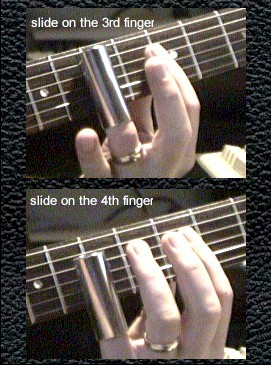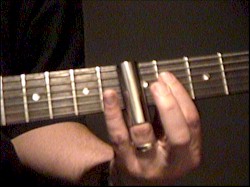Scroll through the lesson and click on notation/video/audio links to load the interactive players.
Please subscribe to get full access to all lessons for only $7.95/month PLUS 1 week free trial.

Riff Interactive lessons are
LESS expensive and
MORE interactive than alternatives!
More Info
|
|

Slide Guitar for Beginners - part 1
Lesson Sample
Lyle: This
series of lessons is for guitarists who have never played slide guitar. It's not
as hard to learn as you might think. It doesn't matter if you use an acoustic or
electric guitar, these lessons can be learned and played on either
type.
Lyle: If you
don't have a slide, you can pick one up for under $8 at your local music store.
There are glass, ceramic, brass, and steel slides and they are available in many
sizes. I like the steel ones because they don't break! You can use them on your
ring finger or your pinky.
slides on fingers

Lyle: You'll always want to play the slide on
TOP of the fret wire, not between the frets. On TOP of the fret wire will put
you in tune. Here's a picture of my slide on TOP of the 5th
fret:
slide at 5th
fret

Lyle: Notice its smack dab on top of the fret
wire. Also, don't press down very hard on the strings; just glide the slide over
them while dragging your index finger along the strings behind the slide. This
will help mute unwanted noise.
Lyle: I'm going to take you through a series
of simple exercises and riffs for most of this lesson, then teach you a simple
solo that you can learn to play along to a jam track.
Lyle: Here's the first exercise. Play the open
G string, and then slide up the 4th string to the top of the 5th fret, which is
a G note. You only want to hear one note at a time. The purpose of this exercise
is to help you get "in tune" and getting you used to playing on top of the
fret.
ex. 1
Lyle: The open G string acts as your target
pitch, and then you slide on the 4th string to the 5th fret, matching that
pitch.
Lyle: Vibrato is easy to do when using a
slide. Just remember to hover around the top of the fret. Watch this video clip
of me playing exercise 1 with slow and fast vibrato:
ex. 1
with vibrato
Lyle: When you do it, do you hear a bunch of
extra string noise? Use the extra fingers on your picking hand to mute some of
the strings that are below the note (string) you are playing. Here's a close-up
video of my picking hand muting the 3rd, 2nd, and 1st
strings:
ex. 1
with mute
mattbusby: Are
you dampening your index finger behind the slide?
Lyle: Yes Matt.
Lyle: Try this next exercise using the 3rd and
2nd strings. Add a little vibrato at the end of each
slide.
ex. 2
Lyle: Now let's try playing a scale on one
string. Play this G minor pentatonic scale using a finger, and then copy that
using the slide.
ex. 3
Lyle: This next exercise is the same scale but
this time you'll be sliding into each
note.
ex. 4
Lyle: Let's try a few simple chords using the
slide, G (open) - C - D - G (12th fret).
ex. 5
dave: What
does the circles mean?
Lyle: Those are the root notes of each chord.
If you play the tab file back on the virtual fretboard, you'll see the root
notes are labeled and highlighted.
Lyle: Next, try exaggerating your slide into
each chord like this:
ex. 6
bluesguitarmp3: What size slide would you suggest I
get teach?
Lyle: One that's not too big and not too small
I guess. I found a size that doesn't fall off my finger from being too
big.
T: Do you
recommend big or small string gauge set up? What about fixed versus Floyd
bridge?
Lyle: I play slide on any type of guitar, any
gauge of strings. It's easier to start out with heavy strings
though.
Lyle: Let's go to the next
part....
Lyle: Let's use these 3 chords, (which happen
to be called the 1-4-5 chords in G) in a 12 bar blues progression. Here's a
chord chart so you can see where each chord is within the
progression:
chord
chart

Lyle: Here's an example of where and when to
play the chords. Remember the G chord can be played open and at the 12th
fret.
chord solo 1
Lyle: Now trying playing chord solo 1 along
with this jam track:
Looping Sound Clip 1
Lyle: Next is a fancier way of playing the
same chords.
ex. 7
Lyle: Use this technique for all 3 chords like
in this next example:
chord solo
2
dave: In bar
12 are you muting the last three cords between moving the
slide?
Lyle: Dave, I'm not muting there, just moving
fast.
Lyle: Remember how you played the G minor
pentatonic on one string earlier in exercises 3 and 4? You can use that scale to
improvise with against the jam track. Here's a real simple way of playing it
along to the jam track, just ascending and descending:
G minor pentatonic solo
T: Do you
recommend distortion or clean sound?
Lyle: For slide I feel it doesn't matter, as
long as you can hear what you're doing and just go for
it.
Lyle: That's all for this lesson.
If you would like further study on this topic or any other topic, email me at
Lyle@theguitar.net for info on how you can get your own customized guitar
lessons like this using Riff Interactive technology. Your private lessons can be
downloaded to your pc for anytime, anywhere study. Thanks and see you at the
next lesson. - Lyle
|
<< load notation from left
|
|
<< load audio from left
|
<< load audio from left
|